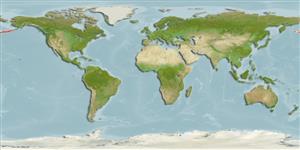>
Perciformes/Cottoidei (Sculpins) >
Liparidae (Snailfishes)
Etymology: Crystallichthys: Latin, cristallum = ice + Greek, ichthys = fish (Ref. 45335); mirabilis: Crystallichthys cameliae (Nalbant, 1965) may be a juvenile of this species (Ref. 51661).
More on authors: Jordan & Gilbert.
Environment: milieu / climate zone / depth range / distribution range
Ecologie
marien demersaal; diepte 53 - 830 m (Ref. 50550). Temperate
North Pacific: Kamchatka, Russia (Ref. 6876) and St. Paul Island, Alaska.
Grootte / Gewicht / Leeftijd
Maturity: Lm ? range ? - ? cm
A recent reference confirming the validity of this species is needed.
Levenscyclus en paargedrag
Maturities | Voortplanting | Spawnings | Egg(s) | Fecundities | Larven
Quast, J.C. and E.L. Hall, 1972. List of fishes of Alaska and adjacent waters with a guide to some of their literature. U.S. Dep. Commer., NOAA Tech. Rep. NMFS SSRF-658, 47 p. (Ref. 6876)
Status op de Rode Lijst van het IUCN (Ref. 130435)
Gevaar voor de mens
Harmless
Gebruik door de mens
Tools
Speciale rapporten
Download XML
Internetbronnen
Estimates based on models
Preferred temperature (Ref.
123201): 1.1 - 4.1, mean 2.1 °C (based on 38 cells).
Fylogenetische diversiteitsindex (Ref.
82804): PD
50 = 0.6250 [Uniqueness, from 0.5 = low to 2.0 = high].
Bayesian length-weight: a=0.01622 (0.00643 - 0.04091), b=3.07 (2.85 - 3.29), in cm total length, based on LWR estimates for this (Sub)family-body shape (Ref.
93245).
Trofisch niveau (Ref.
69278): 3.5 ±0.5 se; based on size and trophs of closest relatives
Weerstandsvermogen (Ref.
120179): Hoog, minimale populatieverdubbelingstijd minder dan 15 maanden (Preliminary K or Fecundity.).
Fishing Vulnerability (Ref.
59153): Low vulnerability (10 of 100).
